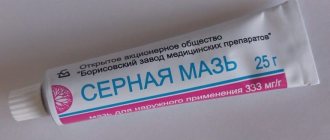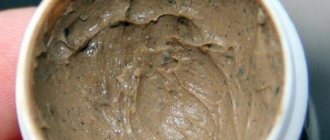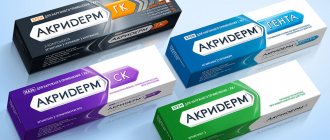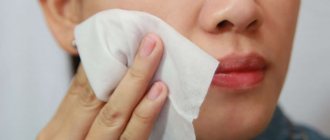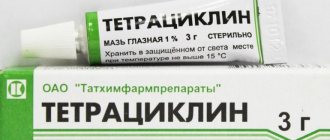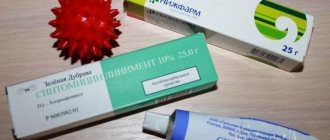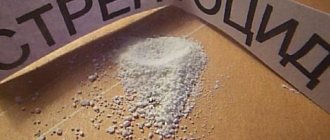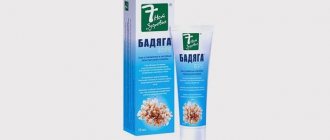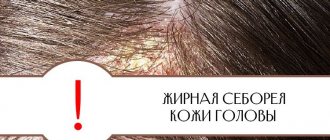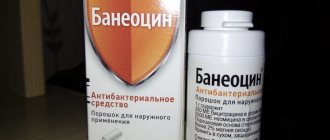Compound
Sulfur ointment is a viscous substance of yellow or light yellow color. The drug consists of sulfur itself and auxiliary components in the form of a mixture:
- soft white paraffin,
- purified water,
- emulsifier T-2.
Soft white paraffin, also known as Vaseline, included in the composition, enhances the healing effect due to its own softening and protective properties. The ointment appears to be homogeneous in composition; small grains are felt to the touch. The concentration of the active substance is 5, 10, 20 or 33% depending on the release form. It goes on sale in dark glass jars or tubes of 25, 30, 40 grams and is sold without a doctor's prescription.
Simple sulfur-based ointment is available in two types: 10% and 33%.
The therapeutic effect is achieved due to the properties of the active substance (precipitated sulfur).
For better absorption of the active compound by the tissues and cells of the epidermis, a consistent emulsion consisting of petroleum jelly and water is also used in production.
Product description: medium density substance, light yellow color, specific smell.
Pharmaceutical companies produce analogues that have a combined composition.
In addition to sulfur, it contains:
- salicylic acid (main purpose – psoriasis, seborrhea);
- birch tar (main purpose – scabies).
For psoriasis
Psoriasis (scaly lichen) is a non-infectious disease that affects the skin. The area affected by psoriasis has a convex shape with a reddish tint, the skin inside the spot is very dry. The cause of the disease is altered leukocytes produced by the body. Therefore, psoriasis is not contagious.
It can be cured with the help of complex treatment, for this you need:
- Use products that are applied to the skin (ointments, oils, infusions).
- Take medications internally.
When choosing external use, you should use an ointment that contains sulfur.
It should be used in the same way as for fungus:
- The affected area also needs to be cleaned, but not steamed.
- Then apply a small layer of the product to the affected areas and the skin around them.
- And leave the drug on all night.
The course should be continued for 10 days; after this period, you need to take a break for a week. Then continue using again. Treatment will not be effective if medications are not used internally, since skin inflammation is caused by disruptions in the internal functioning of the body.
With psoriasis, foci of chronic skin inflammation form in humans. They present as patches of red, dry, flaky skin. Sometimes the so-called “psoriasis spots” become covered with a crust, under which wounds and bleeding cracks form.
Sulfur ointment for psoriasis is used as an antiseptic. However, the drying effect of sulfur is not always suitable for psoriatic “dry” inflammation.
Sulfur-salicylic ointment
The composition of the ointment with salicylic contains significantly less sulfur than simple sulfur ointment. It contains only 2g 100g base (2%). In addition to sulfur, the ointment also contains 2 g of salicylic acid. It significantly enhances the antibacterial and antiseptic effect. It also regulates the secretion of sebum, which provides a drying effect.
In addition, salicylic acid penetrates deeply into the skin and causes increased blood circulation. What accelerates tissue regeneration.
Sulfur-salicylic ointment cleanses pores and dries out inflammation. However, the composition with salicylic acid is irritating. Therefore, it is used for oily skin and not for dry skin. For dry skin, a simple one-component ointment with sulfur is better suited.
Salicylic acid is often used to treat acne. It can cause a burn (if applied as a compress) or dry out the skin too much (if you frequently wipe your face with acid or alcohol). Therefore, they began to use salicyl in a complex manner, adding it to preparations along with other components.
The list of diseases for which sulfur-salicylic ointment is used includes juvenile acne, ringworm, mites under the skin and demodicosis.
Now let’s look at what sulfur ointment helps people with.
Sulfur-tar ointment in folk medicine
And in folk medicine, sulfur-tar ointment is widely known. The use of this remedy has been going on for more than one generation. This medicine was used to treat many diseases, and was even prepared at home.
The use of sulfur-tar ointment in folk medicine
For a long time, sulfur-tar ointment has been used as a natural remedy to combat bedsores and increased skin pigmentation. The drug has also found its use for the treatment of benign tumors, because tar extract can freeze cell growth. Thereby preventing the transition to a malignant tumor. In folk medicine, sulfur-tar ointment was one of the few medicines that could defeat diseases such as smallpox, tuberculosis, abdominal dropsy, otitis media, hemorrhoids and even gangrene. Another amazing property of this ointment is its ability to stop bleeding.
Preparation of sulfur-tar ointment at home
Sulfur-tar ointment consists entirely of natural ingredients and has no preservatives in its composition, which allows you to prepare this medicine at home. To prepare it you will need the following ingredients:
- Fat base or Vaseline – 10 parts;
- Birch tar – 3 parts;
- Sulfur powder - 2 parts.
Place all components of the future ointment in a deep container and mix thoroughly. Then the resulting mixture is heated in a water bath until a homogeneous mass is obtained. Transfer the resulting preparation into a previously prepared clean glass container and let it cool. Homemade ointment should be stored in a cool, dark place.
Sulfur-tar ointment is well known in dermatology and folk medicine. The use of this drug has become widespread. They treat lichen, scabies and acne. But even a natural remedy has contraindications, so consultation with a specialist is necessary before use.
Sulfur ointment for parasitic mites: scabies
Scabies is a parasitic disease in which a microscopic insect, a mite, settles on human skin. The main unpleasant symptom of the disease is severe itching, which accompanies the appearance of parasites. In addition to itching, a small pustular rash appears.
Scabies is transmitted through close contact. To become infected with this parasite, prolonged “body-to-body” contact is required. Therefore, many modern doctors consider scabies a sexually transmitted infection.
Treating scabies with sulfur ointment was popular fifty years ago. Sulfur treatment is still prescribed in post-Soviet countries. European medicine uses other, more aggressive means.
In order to remove ticks with sulfur ointment, in the evening before bed it is applied to the entire surface of the body. For children, the ointment is even rubbed into the face and under the hair.
After sulfur ointment, you should not wash for 24 hours. Afterwards, if necessary, you can take a shower, dry the skin and reapply the ointment.
The choice of concentration of sulfur ointment for scabies is determined by age. For children it is recommended to use a 10% composition, for adults - 20% sulfur ointment. The duration of treatment is a minimum of 3 days – a maximum of 7-8 days. After a week, the person is considered cured.
Features of use depending on the disease
Scabies
To combat subcutaneous mites, ointment is used in a concentration of 10%. The skin of the entire body is subject to treatment.
The medicine should be applied for three days in a row (at night).
You should not take a bath or shower these days.
Clothes must be changed every time. Simple washing does not have an antiparasitic effect, so underwear is boiled or disinfected in another way.
With scabies, the mite most often affects the area between the fingers. After using the medicine, it is not recommended to wash your limbs for at least 3 hours.
Pediculosis
The medicine has a weak effect on lice, and practically no effect on nits.
But due to its safety, the ointment is recommended for children over 3 years of age.
Rules for using the ointment:
- before treatment, the medicine is diluted with water in a ratio of 1:1;
- using a cotton pad, apply to the scalp and the entire length of the strands;
- leave under a plastic cap for 30-40 minutes;
- wash off using shampoo and rinse with water and vinegar (the components are diluted in a 1:1 ratio).
Repeated procedures should be carried out after 3-4 days.
Dermatitis
The procedure schedule is 2 times a day.
Duration of therapy is 3-7 days. It is recommended to use 5% ointment.
Fungal infections
Focal areas of the body are treated 1-2 times a day.
https://www.youtube.com/watch?v=EugUaIEsd4Q
For 5 days, taking a bath or shower is prohibited, but clothes will need to be changed daily.
At the end of the period, the remnants of the ointment are washed off and clean underwear is put on. All removed clothing must be disinfected.
Sulfur ointment and demodicosis
In addition to the well-known scabies mite, a person’s skin can become infected with another mite-borne parasite - the glandular acne. This microscopic insect settles in the ducts of the sebaceous glands and hair follicles. The ironweed prefers the skin of the face, settling on the forehead, chin, nasolabial folds, eyelids and in the outer part of the ear canals.
Infection with this parasite occurs unnoticed. Its appearance is accompanied by the sudden development of large pink pimples on the face. The skin infection becomes chronic and periodically worsens (during the off-season - spring, autumn).
Ironworm infection is called demodicosis. The use of sulfur ointment for demodicosis consists of applying it to the face twice a day (morning and evening). Treatment periods are long, from one to three months.
Review of anti-scar medications
It is safer to entrust the choice of a remedy to a doctor, especially after the appearance of surgical scars - with appendicitis, hernia, etc. Thus, retinoic ointment is effective for acne and post-acne, but in the case of traumatic scars it is powerless. The silicone-based drug "Strataderm" copes with scars and scars, eliminates stretch marks, but is expensive. Moreover, one tube is not enough to carry out a treatment course.
Let's consider a list of popular products for scars that are effective and do not put a strain on the family budget.
| Name of ointment | Action | Mode of application |
| Contractubex | The German drug contains heparin and allantoin. These components help break down scar tissue and improve regeneration. The drug has a positive effect on the skin structure, softens pathological tissue and makes the epidermis elastic. The ointment contains onion extract. This ingredient has an anti-inflammatory effect, improves blood microcirculation and inhibits the proliferation of connective tissue. | Contractubex is applied to the affected area three times a day for a month. The drug is prescribed at the early stage of scarring and for prevention. The drug is ineffective against old scars. |
| Dermatix | A Dutch-made drug in the form of a gel-like mass. It is used immediately after the wound has healed to prevent scarring. The product eliminates pigmentation, improves blood supply to epidermal cells, and saturates the connective tissue with moisture. | Dermatix is applied twice daily. The drug is quickly absorbed and leaves no traces. Duration of therapy is 2 months. The drug will not help with deep skin damage. But it is safe and suitable for use by children and pregnant women. |
| Fermenkol | Active collagen preparation made in Russia. Stimulates the resorption of existing scars and prevents new ones. Makes convex formations flat and elastic. At the same time it has an analgesic and antipruritic effect. Side effects to the ointment are rare, so the product is recommended for use in children. | Use the product twice a day for a month. Fermenkol removes hypertrophic scars on the body. To increase the effectiveness of therapy, the drug is used as part of medicinal electrophoresis. |
| Solcoseryl | The drug improves cell regeneration and nutrition. It is applied to the face for acne and post-acne. The ointment will be useful for dry wounds, frostbite, burns, and cuts. Zinc ointment works similarly. It is cheaper and suitable for the treatment of dermatitis, bedsores, dry and weeping wounds. Both drugs do not have a pronounced anti-scar effect. But using them early will prevent scarring. | The ointment should be used twice a day. At the stage of scar formation, the drug is used under a bandage. |
| Clearvin | This cream softens the skin, activates cellular metabolism, and improves blood circulation. Contains natural ingredients and belongs to Ayurvedic preparations. Effective against comedones, stretch marks, age spots, skin microdamages. Suitable for treating acne, smoothes the skin, eliminates signs of chronic fatigue. | The skin is lubricated morning and evening for several weeks. Doctors consider the drug as a cosmetic product, but the natural base and safety of the cream distinguish it from other drugs. For minor disorders and for their prevention, the product will be effective. |
| Imoferase | The cream is intended directly for the removal of scars and scars. Hyaluronidase, which is part of the cream, inhibits the growth of connective tissue and reduces swelling. During a course of treatment, convex formations decrease in volume, the level of pigmentation decreases, and elasticity increases. Imoferase cream acts on old scars and scars, reducing their density. | The effect of treatment is noticeable after 3 weeks, the full course of therapy is 8 weeks. It is recommended to use the cream after operations, burns, cesarean section and in case of traumatic skin damage. |
| Heparin ointment | The drug improves blood microcirculation, which allows it to be used for stretch marks, hematomas, localized infiltrates and ulcerative lesions. It will not be possible to get rid of scars with heparin ointment, but prophylactic use of the product will prevent pathological growth of connective tissue. | Heparin ointment is applied up to 3 times a day for 2 weeks. |
| Methyluracil | Forces regenerative processes, improves renewal of epidermal cells. The ointment heals wounds by speeding up epithelization. It has a protective property, restores the integrity of the skin, and prevents degenerative changes in the epidermis. Used after burns, including radiation. Bepanten cream works in a similar way. The list of indications for the drugs is comparable. | The duration of therapy is 1-4 months. An analogue of the drug is called Levomekol ointment. This is a combination drug based on methyluracil. |
| Vishnevsky | The ointment resolves seals and activates restoration processes. The drug is distinguished by its dark color, pungent odor, and affordable price. The drug is not able to get rid of scars and rough scars. But it is used to eliminate the consequences of chickenpox, acne, and dermatological diseases. Compresses with Vishnevsky ointment are effective. | The drug is mixed with honey in equal proportions, applied to the skin, covered with a cabbage leaf, then with film and left for an hour. Ichthyol ointment works in a similar way. |
| Hydrocortisone | The ointment has anti-inflammatory properties and inhibits the growth of connective tissue. It is used after blepharoplasty and eyelid pathology. Hydrocortisone ointment is a glucocorticosteroid, which explains the impressive list of contraindications and side effects. | The ointment is used for 2 weeks, treating the skin surface up to 4 times daily. |
"Anti-scar" - promotes collagen production
The gel reduces scarring of the skin after wounds, burns, surgeries, acne, and stretch marks on the body. Anti-scar ointment based on Mg improves collagen synthesis and thereby changes the structure of the scar, promoting its disappearance. The drug has additional effects: softens the skin, increases its elasticity, reduces wrinkles on the face and resolves scars and stretch marks.
Directions for use: Apply a small amount of gel with massaging movements to problem areas of the body 2 times a day. The minimum course of treatment is 2 weeks.
Kelo-cote – treatment of scars after surgical interventions
The gel was produced by the American company Advanced Bio-Techologies using a unique technology. Its main purpose is the prevention and treatment of scars after surgery. Fights against such types of scars: keloid, hypertrophic, atrophic and others. It is safe to use, therefore it is prescribed to both adults and children.
Apply Kelo-Coat to dry skin morning and evening for 60-90 days. Within 2 months the results will be noticeable: itching, pain, inflammation and tightness on the skin will disappear. Also used to heal wounds and scratches.
“Rescuer” - helps with burn scars
If you receive household burns, it is recommended to apply Rescuer in a thin layer to the affected area of the skin. The ointment cleans the injured surface, disinfects it and promotes rapid wound healing, preventing the appearance of scars. Rescuer ointment is not hormonal, so it is not addictive.
The drug can also be used to treat sunburn. It soothes the skin, reduces redness and promotes rapid healing.
Instructions for use
General recommendations for using a dermatological product:
- the affected areas are treated with medicine 2-3 times a day;
- The ointment should be applied exclusively to the focal area, the surface of healthy skin is affected only 1-1.5 cm at the edges;
- a thin layer of medicine is formed (it is rubbed in in a circular motion);
- The duration of therapy is determined by the attending physician (on average, the course lasts 3-10 days).
The method of treating lesions depends on the nature of the disease. For minor lesions, the ointment is applied once a day; the presence of large areas requires frequent procedures (up to 3 times a day).
Before carrying out the treatment procedure, the skin on which the pathological manifestations are located is washed with soap and dried with a towel.
The medicine is distributed only over dry skin.
For one-time processing, you should choose the evening time. Throughout the night, the active components will work in the outbreak, fighting the pathological process.
There is no need to rinse off the product before going to bed.
Scabies
To combat subcutaneous mites, ointment is used in a concentration of 10%. The skin of the entire body is subject to treatment.
The medicine should be applied for three days in a row (at night).
You should not take a bath or shower these days.
Clothes must be changed every time. Simple washing does not have an antiparasitic effect, so underwear is boiled or disinfected in another way.
With scabies, the mite most often affects the area between the fingers. After using the medicine, it is not recommended to wash your limbs for at least 3 hours.
Pediculosis
The medicine has a weak effect on lice, and practically no effect on nits.
But due to its safety, the ointment is recommended for children over 3 years of age.
Rules for using the ointment:
- before treatment, the medicine is diluted with water in a ratio of 1:1;
- using a cotton pad, apply to the scalp and the entire length of the strands;
- leave under a plastic cap for 30-40 minutes;
- wash off using shampoo and rinse with water and vinegar (the components are diluted in a 1:1 ratio).
Repeated procedures should be carried out after 3-4 days.
Dermatitis
The procedure schedule is 2 times a day.
Duration of therapy is 3-7 days. It is recommended to use 5% ointment.
Fungal infections
Focal areas of the body are treated 1-2 times a day.
For 5 days, taking a bath or shower is prohibited, but clothes will need to be changed daily.
At the end of the period, the remnants of the ointment are washed off and clean underwear is put on. All removed clothing must be disinfected.
Sulfur ointment owes its healing properties to sulfides and pentathionic acid, which are formed when sulfur reacts with organic substances in the skin. Thus, it has antimicrobial, antiparasitic and antifungal properties, as well as the ability to restore the affected areas of the upper layer of the skin - the epidermis.
The concentration of sulfur ointment is of great importance. With a low percentage of sulfur, it will promote the healing of small wounds and defects that have arisen on the affected skin and activate the formation of new cells. Quite quickly after the start of treatment, the inflamed areas stop itching.
The use of 33 percent sulfur ointment allows you to loosen the upper layers of the skin with subsequent removal of dead areas, for example, with seborrhea. This process is facilitated by irritation of skin receptors, which leads to improved blood supply to the treated areas. This speeds up metabolism in the epidermis and speeds up recovery.
The choice of concentration of the ointment, as well as the scheme of its use, depends on the specific skin disease, the severity of the disease and requires consultation with a specialist. With its help you can successfully treat:
- scabies,
- lichen,
- various dermatitis,
- seborrhea,
- eczema,
- psoriasis,
- demodicosis,
- fungus.
The term dermatitis combines a group of skin pathologies that manifest themselves in response to various irritants in the form of rashes, redness and itching. Such manifestations are usually based on an allergic reaction, therefore, using sulfur ointment, you can relieve irritation, reduce inflamed areas, and with a weeping form - reduce pain as a result of the drying effect. However, a disease can be completely cured only after its cause is eliminated.
Seborrheic dermatitis most often affects the scalp, although it can also appear on other areas of the skin. The disease is associated with increased secretion of the sebaceous glands. Severe peeling, accompanied by itching, leads to the formation of crusts, which can often be observed in newborns.
It should be remembered that the disease is not as simple as it seems. It is provoked by gastrointestinal problems, disorders of the nervous system, hormonal imbalance, and stress. Therefore, as with any other dermatitis, other strong drugs, including hormonal ones, will be needed for treatment.
Eczema is characterized by various skin lesions: from itchy, weeping blisters to profuse redness with dry cracks, accompanied by a burning sensation. Proceeding in an acute or chronic form, it has a cyclical nature, either subsiding after treatment or exacerbating again. Particular mental discomfort is caused by frequent damage to open areas.
Sulfur ointment for eczema creates a protective barrier against the penetration of pathogenic microorganisms through inflamed areas and can be used not only on the hands, but also on more delicate areas - the face and neck. In the weeping form, sulfur-zinc ointment has a powerful antiseptic effect.
There are many methods and special medications for the treatment of seborrhea, which, when properly prescribed, give remarkable results. One of the favorite forms of medications for seborrhea are all kinds of ointments. The popularity of such funds is explained by several factors:
- Disinfect the surface
- Suppresses the growth of various fungi
- Softens dry crusts, promoting their healing and elimination
- Activate the healing of the epidermis
- Accelerate the formation of new skin cells and, accordingly, renewal of the skin
- Cleans the surface of dandruff.
In addition to therapeutic effects, the advantage of ointments for seborrhea is their affordability and the availability of a variety of drugs in pharmacies: from the simplest to the latest developments.
The disadvantages of ointments include a specific, not always pleasant smell, difficulty in rinsing, as well as a long treatment period. But even with these difficulties, the effect of using ointments for seborrhea still outweighs their disadvantages.
The antiseborrheic effect of the ointment is achieved by the properties of its main component - sulfur. The substance is famous for its strong anti-dandruff effect and inhibitory effect on various pathogenic microorganisms.
After application to the skin, it penetrates into the layers of the dermis and, under the influence of the organic acids present, forms sulfides and pantothenic acid, which have a powerful antimicrobial and antiparasitic effect.
Sulfur ointment for seborrhea is prescribed in complex, advanced cases when previous treatment has not had a positive effect. In these cases, an ointment with a 33.3 percent sulfur content is used; for milder cases, an ointment with a lower sulfur concentration (10%) is used.
The advantage of the drug is that it does not dry the skin, so it can be used on any type of hair, but a particularly strong effect is manifested with dry and mixed hair.
Sulfur ointment relieves dandruff by suppressing the increased activity of fungi, eliminating the inflammatory process and at the same time promoting the healing of damage and normalization of the skin.
The duration of therapy should be determined by the treating specialist, but generally it is 2-3 weeks. The ointment is applied daily to previously washed and dried scalp, left for 5 minutes, then washed off. After a week-long course, you need to take a break for at least a day, and then resume treatment.
During procedures, it must be taken into account that the sulfur contained in the ointment is highly toxic. Therefore, it can cause irritation of mucous tissues and respiratory organs.
In people with normal immunity, the ointment does not provoke negative side reactions. They are possible only in patients with a high level of sensitivity to the components of the ointment. In this case, there is a burning sensation in the areas where the ointment is applied, itching and other individual symptoms. When they appear, sulfur ointment is canceled.
It is highly undesirable to use the ointment longer than prescribed by the doctor, so as not to aggravate the skin condition. If sulfur ointment for seborrhea does not help, then it is better to undergo additional examination and find out the actual cause of the pathology.
A cheap and effective remedy for various skin lesions. The ointment can be used to treat burns, skin inflammation, acne, scabies, and of course, seborrheic dermatitis.
The effect of the main component of sulfur is enhanced by the inclusion of salicylic ointment in the composition. The concentration of substances is 2% and 5%. Thanks to the interaction of two substances, the ointment has a combined effect:
- Has antiparasitic and antimicrobial effect
- An ointment with a small content of substances accelerates tissue regeneration, a more concentrated product helps soften and more easily separate keratinized scales.
Sulfur has an anti-dandruff effect, suppressing the activity of microorganisms, salicylic acid enhances its effect, relieves inflammatory processes on the skin and disinfects.
For seborrhea, it is recommended to use 2% ointment. It is applied to the scalp and left for 2-3 hours. There is no need to cover your hair with anything so as not to interfere with the functioning of the follicles. After this, the drug is washed off with neutral shampoo. It is recommended to use sulfur-salicylic ointment for seborrheic dermatitis for at least a month.
Such treatment is usually well tolerated by the body if the patient is not allergic to sulfur and salicylic acid. For some people, the ointment may cause itching and dry skin. If unpleasant sensations occur, it is better to discontinue the medication and consult a doctor to determine further actions.
What is the cause of seborrhea and how does it manifest itself?
The disease usually first appears in adolescence and can recur regularly throughout life. The exact causes of the pathology have not yet been established, but it is assumed that seborrhea occurs due to hormonal imbalance in the body, heredity, and disturbances in the functioning of the gastrointestinal tract. But most often the culprits are various pathogens.
Damage to the scalp is one of the types of chronic dermatitis. Basically, the pathology is provoked by microorganisms present in the human body. In a normal state of immunity, they usually do not manifest themselves, but as soon as internal failures occur and, as a result, favorable conditions are created, they begin to actively reproduce.
Favorite places for the formation of colonies of microorganisms are areas of the skin with a large accumulation of sebaceous glands, which, under the influence of certain factors, produce large amounts of sebum. Therefore, the development of seborrhea (seborrheic dermatitis) usually occurs in the upper part of the head. The disease can also affect the skin of the face, upper back and chest.
The success of treating seborrheic dermatitis, like any other pathology, depends on the correct determination of the type of disease. There are several types of disease:
- Dry type of seborrhea: manifested by abundant, loose, white dandruff. Accompanied by severe itching in the affected areas, dryness and brittleness of the hair shafts.
- Oily type: characterized by overactive sebum production by the sebaceous glands. Therefore, the hair quickly becomes covered with plaque the very next day after washing your hair. A scattering of yellowish scales appears on the head, the skin itches and itches.
- Mixed type of seborrhea. It is characterized by a combination of dry and oily types of seborrhea in different areas on the scalp.
Establishing the exact causes of dry seborrheic dermatitis is one of the main stages of effective treatment. Don't be surprised if your dermatologist refers you to other specialists for examination before starting treatment. This could be a direction to:
- gynecologist;
- gastroenterologist;
- endocrinologist, etc.
The thing is that with dry seborrhea of the skin, an integrated approach is important. It is highly desirable that hormonal levels be brought back to normal, as well as the digestive system and emotional state. But this is not a complete list of possible reasons.
The most common causes of dry seborrhea of the scalp:
- reduced immunity;
- poor hair hygiene (inappropriate washing products, frequent use of hair straighteners and hair dryers);
- insufficient intake of vitamins;
- thyroid disorders;
- poor functioning of the digestive tract;
- too frequent and high physical activity;
- diabetes;
- hereditary causes.
And only when all problems with other body systems are normalized, you can begin to directly treat dry seborrhea of the scalp.
Naturally, it is impossible to cure seborrheic dermatitis with diet alone. To do this, the dermatologist must prescribe some kind of medication. The type of drug will depend on the symptoms and type of disease.
Sulfur ointment 10%
Dry seborrhea of the scalp is often treated with sulfur ointment. For dry seborrhea, doctors often recommend sulfur ointment 10%. This is a very effective remedy, which is also absolutely safe. The only downside is that the ointment does not smell very nice and stains the bed linen a lot.
The use of the product is very simple - the ointment is gently rubbed into the scalp. This needs to be done for about a week, after which a day later you need to wash your hair with some medicated shampoo.
To consolidate the result, the hair is treated with a solution of boric acid at the rate of 150 g for the next three days. water and 2 teaspoons of acid. The solution is rubbed into the scalp before bed and wrapped in a towel. In the morning, hair should be washed with medicated shampoo.
Dry seborrhea of the scalp is treated very successfully with an ointment based on sulfur and salicylic acid. This product is for external use and is available in almost every pharmacy. You don't need a prescription to buy it, and the price is not high.
The ointment has an antibacterial and antiparasitic effect. Salicylic acid reduces inflammation, sulfur fights bacteria.
This ointment also has antiseptic and antibacterial properties. It is freely sold in pharmacies and has a low price. Sulfur-tar ointment has had excellent reviews from cured patients for quite some time and can rightfully bear the title of an effective remedy for dry seborrhea of the scalp.
Medicinal shampoos
The mechanism of action of medicated shampoos for dry seborrhea is very simple; it is to remove the increased activity of the fungus on the scalp and thereby get rid of dandruff.
Shampoos do not treat dry seborrhea of the scalp, but kill the fungus, so there is an option that after stopping the use of shampoo, the disease will return again. In addition, shampoos have another drawback and it is that they are quickly washed off - the necessary substances simply do not have time to act to the extent necessary.
In general, there are many shampoos for dry seborrhea of the scalp. They are divided into:
- containing phytoextracts;
- antifungal;
- antibacterial;
- exfoliating.
The most common products are those containing zinc or tar. Both of them perfectly eliminate dandruff. Take the choice of shampoo against dry seborrhea seriously and carefully - it is useless to treat dry seborrhea with shampoo against oily seborrhea.
Sulsena paste
This time-tested remedy comes from the Soviet Union. During this time, it has not lost its effectiveness and copes well with dry seborrheic dermatitis and treats dry seborrhea of the scalp.
Selenium disulfide is the main active ingredient of the drug. It has an anti-inflammatory effect and soothes the scalp, relieving itching. The main advantage of Sulsena paste is that it specifically treats dry seborrhea of the scalp, and not only eliminates unpleasant symptoms. Those. its action is directly aimed at normalizing the functioning of the sebaceous glands.
Sulsen ointment must be prescribed by a doctor, although it is sold without a prescription and has virtually no side effects. The Sulsen product line includes soap and medicated shampoo. Both of these products also contain selenium disulfide and are effective in getting rid of dandruff. You can use them independently, without a doctor’s prescription, as a preventive measure. Contact of these products with the eyes should be avoided.
In addition to drug treatment, you can also resort to traditional medicine. Of course, this is not as effective as pharmaceutical drugs, however, for additional treatment or prevention of dry seborrhea, folk remedies can also be very useful.
Using homemade masks will also bring relief and speed up the treatment of dry scalp seborrhea. Probably the most popular of them among those who are sick is a mask with henna.
You need to take any nourishing cream and henna powder at a ratio of 7:1. Henna needs to be diluted with 2 parts of water and combined with cream. Stir gently and slowly rub into scalp. To get the result, you need to do the procedure at least 10-12 times.
For dry seborrhea of the scalp, decoctions of some herbs that have anti-inflammatory properties are also used. These herbs include:
- nettle;
- hops (cones);
- chamomile;
- calamus root;
- thyme;
- plantain;
- St. John's wort and many others.
The principle of treatment is simple - you need to rinse your head with the prepared and cooled decoction. The effect will be enhanced if, after the procedure, you tie your head with polyethylene and hold this bandage for 30 minutes. Carry out such rinsing once a day until the desired effect is obtained.
Sulfur ointment for nail fungus
Fungal infections of the skin and nails are also treated with sulfur ointment. It is applied to the nail plate and adjacent areas of the skin once a day (at night, after a bath, just before bed). The treatment period for fungus with sulfur ointment is about a week.
Sulfur ointment is universal. Its composition acts against various fungal infections. However, it may not be effective enough. In this case, sulfur ointment is replaced with a more aggressive drug - sulfur-salicylic ointment.
Other ointments for fungus
Oils
Since with dry seborrhea the amount of oil secreted by the skin is insufficient, it makes sense to rub various oils into the scalp. This can be: olive oil, castor oil, as well as sea buckthorn or parsley oil.
Separately, it is necessary to note burdock oil, which is widely used for hair treatment. It should be applied to the scalp and left for 2 hours, then rinsed off carefully. Repeat the procedure no more than 2 times every 10 days for a month.
As you can see, the treatment of dry seborrhea of the scalp can be done using different methods. A specialist will decide which one is best. You just have to strictly follow the recommendations and carefully monitor the dosage of the medicine.
Sulfur ointment for face
The use of sulfur ointment for the face is explained by its keroplastic properties. Sulfur sulfide helps exfoliate old skin cells and form new ones. This maintains the elasticity of the skin and the youthfulness of the face.
In addition, the antiseptic properties allow the ointment to be used for various types of acne. Sulfur ointment for acne on the face helps cure medium acne (pimples). Severely inflamed acne requires more aggressive medications.
By using sulfur ointment for acne, we also regulate the functioning of the sebaceous glands. Sulfur normalizes the secretion of sebum, on which pathogenic bacteria multiply. This also affects the number and size of acne - there are fewer of them.
Sulfur ointment is a simple preparation that combines several cosmetic properties. It prevents the proliferation of bacteria (it is their metabolic products that clog pores with “blackheads”). It dries out inflamed pores (in the accumulations of which infection multiplies). It also exfoliates dead cells (which accumulate in the recesses).
Does sulfur ointment help against wrinkles? No, the sulfur composition has antiseptic properties and a slight keratolytic effect, but it is not able to remove even small expression wrinkles.
Side effects
Simple sulfur ointment (what it can help with will be described below) helps with most skin diseases if the cause of the rash is external factors and not internal ones (indigestion, poor diet, etc.). The effect is achieved thanks to the sulfur contained in the ointment.
When exposed to the skin, sulfur forms an acid that directly attacks the cause of acne, rashes and ulcers, namely:
- microbes;
- fungus;
- parasites (subcutaneous mites).
The acid completely destroys the cause of inflammation, and the Vaseline and glycerin contained in the composition treat redness and normalize cell regeneration.
When using the drug, side effects are extremely rare.
However, with prolonged use, the following may develop:
- Dizziness, pain in different areas of the head.
- Temperature increase
- Itching.
- Burning.
- Skin redness.
- Slight swelling of the area where the product was applied.
- Peeling of individual areas of the skin.
The above ailments go away on their own after stopping therapy with sulfur ointment. Experts in the field of dermatology do not recommend using the product for too long, since the sulfur contained in the composition tends to be deposited in the body.
This can become an impetus for the development of certain diseases and cause disturbances in the functioning of the body or individual organs. However, such side effects are rare, since the ointment is highly effective and can cope with dermatological problems in a short time.
Sulfur ointment and pregnancy
Clinical trials have not been conducted for this category of patients.
Theoretically, the composition cannot cause harm to the health of the woman and the fetus. In case of urgent need, the drug can be used for the treatment of dermatological diseases, but in agreement with the doctor managing the pregnancy.
It is important to read the package insert before using for the first time. Attention is paid not only to the question of what the ointment is used for, but also to its ability to provoke an allergic reaction.
You can check this using a test: apply the product to the back of your hand and leave for 10-15 minutes.
The absence of redness or burning is evidence of the safety of the drug.
During lactation, the sulfur composition can be used on different parts of the body, except the chest.
Sulfur ointment for acne
Experts recommend using sulfur ointment with a concentration of 10% for acne on the face.
This composition has a gentle effect on the skin and subcutaneous processes.
Sulfur quickly penetrates the layers of the dermis and destroys pathogens. The first contact with the skin is accompanied by a slight burning sensation, which disappears after 2-3 minutes.
The composition with an active substance content of 33% is suitable for eliminating acne and treating old scars.
This type of ointment acts more aggressively, but the effect is worth it. The only caveat is not to use it on your face.
No trace remains of serious lesions after a course of treatment.
To prevent the development of adverse reactions, it is recommended to first read the instructions. This is especially true for the sections: indications for use, how to carry out procedures and contraindications.
It is not worth carrying out the procedure frequently; the sulfur composition dries out the skin.
Mechanism of action
Sulfur paste has pronounced antifungal, antiparasitic and keratolytic properties, which determine the medicinal qualities of the drug. Therefore, it is often used in cosmetology. When applied to the affected skin, the medication begins to interact with organic substances, forming sulfide compounds and pantothenic acid.
Thanks to the components of the product and accompanying derivatives, a targeted effect is exerted on the pathogenic microflora, preventing its vital activity. Sulfur quickly relieves inflammatory processes, prevents the development of acne, gets rid of blackheads and age spots, and helps with wrinkles. The ointment improves microcirculation and blood circulation.
The drug has an exfoliating effect, eliminating acne spots. It also eliminates swelling and removes pus from the pores. This product reduces the production of sebaceous secretions, which is the main cause of oily skin.
The ointment, which contains 33% sulfur, helps get rid of scars, scars, and subcutaneous acne. The components of the drug, together with sulfides, help activate the biochemical processes of restoration of the epidermis. The medication does not penetrate the systemic bloodstream, therefore it is considered a safe drug. However, it should only be used as prescribed by a doctor in recommended dosages.
This ointment has the following indications for use:
- acne;
- mycoses;
- seborrhea;
- psoriasis;
- demodicosis;
- lichen.
Sulfur ointment for seborrhea
The disease usually first appears in adolescence and can recur regularly throughout life. The exact causes of the pathology have not yet been established, but it is assumed that seborrhea occurs due to hormonal imbalance in the body, heredity, and disturbances in the functioning of the gastrointestinal tract. But most often the culprits are various pathogens.
Damage to the scalp is one of the types of chronic dermatitis. Basically, the pathology is provoked by microorganisms present in the human body. In a normal state of immunity, they usually do not manifest themselves, but as soon as internal failures occur and, as a result, favorable conditions are created, they begin to actively reproduce.
Favorite places for the formation of colonies of microorganisms are areas of the skin with a large accumulation of sebaceous glands, which, under the influence of certain factors, produce large amounts of sebum. Therefore, the development of seborrhea (seborrheic dermatitis) usually occurs in the upper part of the head. The disease can also affect the skin of the face, upper back and chest.
The success of treating seborrheic dermatitis, like any other pathology, depends on the correct determination of the type of disease. There are several types of disease:
- Dry type of seborrhea: manifested by abundant, loose, white dandruff. Accompanied by severe itching in the affected areas, dryness and brittleness of the hair shafts.
- Oily type: characterized by overactive sebum production by the sebaceous glands. Therefore, the hair quickly becomes covered with plaque the very next day after washing your hair. A scattering of yellowish scales appears on the head, the skin itches and itches.
- Mixed type of seborrhea. It is characterized by a combination of dry and oily types of seborrhea in different areas on the scalp.
The use of ointment by pregnant and lactating women is not recommended, but it is possible if necessary. In these cases, use an ointment with a 2% content of components.
In the complex treatment of seborrhea of the scalp, it is necessary to take into account the ability of Sulfur-salicylic ointment to enhance the effect of other external agents due to the locally irritating effect it produces. In addition, the ointment should not be combined simultaneously with medications that contain resorcinol and zinc oxide. Otherwise, no particularly negative consequences of combination with other drugs are mentioned in the instructions for the drug.
The use of hair ointments for seborrhea helps get rid of the infection and normalize the functioning of the sebaceous glands. But despite their effectiveness, the success of treatment also depends on other factors: correct diagnosis, selection of the most effective drugs and systematic implementation of medical prescriptions by patients.
Seborrhea is a fungal skin disease that is simply called “dandruff”. The cause of seborrhea (or seborrheic dermatitis) is a fungal infection of the skin in the scalp. It is manifested by itching and flaking, while small particles of skin (dandruff) appear on the hair.
Sulfur can cure fungal infections. To do this, sulfur ointment is applied to the skin between the hair once a day. Treatment time is 7-10 days.
Why does dandruff appear?
Microscopic bacteria and fungi are constantly present on human skin. During normal functioning of the body, their reproduction and pathogenic activity are restrained by internal defense mechanisms. As a result, potentially dangerous microorganisms remain invisible to humans.
But the slightest disruption of a perfectly balanced system (which is often observed with an unhealthy lifestyle, stress, hormonal imbalances) leads to the formation of favorable conditions for the growth of pathogenic microflora.
When the above failures occur, the likelihood of seborrhea formation increases. We are talking about an unpleasant dermatological disease, accompanied by peeling of the epithelial layer of the epidermis. Often it signals a dysfunction of organs or a specific system in the patient’s body.
Several factors can trigger the appearance of dandruff:
- neglect of hygiene rules and basic recommendations for body care;
- dysfunction at the level of the system or individual organs (hormonal imbalances, problems with the performance of the digestive system, etc.);
- constant (episodic) stressful situations;
- nominal physical activity, short stay in fresh air.
The listed reasons significantly increase the likelihood of an unpleasant dermatological disease. There are several ways to get rid of seborrhea of the scalp. Below we will talk about the most effective and widely available medicine, with which you can eliminate the manifestations of a common illness.
Ointment for seborrhea (dandruff) on the head: advantages and disadvantages of this product
Our ancestors have used ointments since time immemorial; they were invariably present in the arsenal of herbalists, folk healers, and healers. Such preparations were prepared only from natural ingredients (oak bark, pine buds, tar, etc.). Their recipe was constantly improved, supplemented and adjusted.
Modern pharmaceuticals have in no way shaken the leading position of ointments, but have only secured their status as the most effective medicines for the treatment of various ailments. They are also used for seborrhea of the head, in particular sulfur ointment.
The main advantages of liniments:
- Therapeutic ointments have pronounced antifungal, antiseptic and antimicrobial properties.
- Wound healing effect. One of the causes of epithelial peeling is damage to the upper layer of the epidermis. The ointment has a viscous consistency, and after application to the surface of the problem area of the skin, it activates regeneration at the cellular level. This therapeutic effect is extremely important in the active treatment of seborrhea.
- Specialized liniments have softening properties.
Like any other medicine, ointments have a number of disadvantages. The main “minus” of the dosage form in question is the impossibility of use for oily seborrhea. Patients also complain about the difficulty of washing off the oily composition from the head after application. In 90% of cases, these pharmaceuticals have a specific odor, which automatically implies the need to get rid of it.
But to get rid of mixed and dry dandruff, ointment is the best and safest solution.
Interaction
Dermatological ointment is often included in complex therapy.
Depending on what it is prescribed for, combinations of drugs are selected:
- for dermatitis - sulfuric zinc ointment;
- for oily seborrhea - sulfur salicylic ointment;
- for scabies - sulfur permethrin ointment.
You should not combine pharmacological agents on your own due to a possible decrease in the therapeutic effect due to incompatibility of the compositions.
Cost in pharmacies
You can purchase this product at any pharmacy without a doctor's prescription. Sulfur ointment is an inexpensive and effective remedy for combating skin diseases.
| In Moscow and Moscow region | 35-50 rub. |
| In St. Petersburg | 22 -31 rub. |
| In Kazan | 28-38 rub. |
| In Novosibirsk | 25-28 rub. |
The price of sulfur ointment in all regions of Russia does not exceed 70 rubles. Despite the low price, the product is very effective and practically harmless.
Sulfur ointment for lichen
Usually the word lichen refers to fungal infections of the skin. This infectious disease in medical terminology is called microsporia or trichophytosis, and in the generally accepted version - ringworm. To treat it, you can use an inexpensive salicylic-sulfur composition. However, there are other, more effective means.
The sulfur composition has remained popular in the treatment of lichen in animals. Thus, veterinarians recommend using sulfur ointment for cats with large areas affected by lichen, if it is necessary to treat the entire body. It is also recommended to supplement treatment with internal antifungal medication.
Pros and cons of sulfur ointment
Advantages:
- simple composition and absence of insecticides harmful to humans;
- simple rules of use;
- does not dry out hair and skin; quickly heals small bites and wounds left by lice;
- suitable for children. Flaws:
- the effect on lice and nits is weaker than that of similar products;
- one-time use does not lead to the disappearance of parasites;
- unable to cope with parasites if the disease is advanced.
Reviews
Snezhana, 42 years old, Tyrnyauz I use sulfur ointment everywhere. It's a little itchy - I apply it. It helps and costs a penny.
Ivana, 34 years old, Dzerzhinsk, treated her daughter’s lichen with sulfur ointment. The doctor prescribed treatment with iodine and sulfur ointment. He said that these simple remedies for lichen are time-tested. And that cheap drugs help no worse than expensive ones. Within a week, the lichen was gone.
Mikhail, 50 years old, Sapozhok village I read on the forums that sulfur ointment helps against fungus on the nail. I tried it. I applied it under the bandage at night and washed it off in the morning so it didn’t stink. After a week I noticed slight improvements. After two weeks it was already noticeably better. In general, I cured it, cheaply and cheerfully.
Artem Rodionovich, Kuznetsk Sulfur ointment against fungus helps at the onset of the disease. If the fungus is old, it will not help.
After a vacation in the village, three itchy red dots appeared on my son’s arm, which gradually increased in size.
The doctor gave a verdict - lichen. He suggested several drug options for treatment. After studying the annotations, I chose sulfur ointment, since its composition turned out to be the safest.
It was possible to get rid of lichen in just a week by treating the lesion twice a day. The product surprised me with its rare combination of affordable price and effectiveness.
I often go on business trips by train and use government-issued bedding. Apparently she “brought” scabies from there.
I had never encountered such a problem before, so I went to the doctor when the itching spread from my hands to my forearms. The dermatologist prescribed sulfur ointment for scabies.
The product was applied to the skin 2 times a day for 5 days. Surprisingly, the drug worked. No repeated treatments were carried out.
Dermatitis appeared while I was at the dacha.
There are no pharmacies nearby in the village, so I began to treat myself with what was in my home medicine cabinet.
This did not give any results until a neighbor brought sulfur ointment. After 4 days of treatment, the symptoms disappeared.
Use in cosmetology
Sulfur, the main component of the drug, has long been known for its strong antiseptic properties. Therefore, sulfur ointment is used for a face affected by acne or acne. Healing properties of the drug:
- does not allow microorganisms to develop,
- relieves inflammation
- has a softening effect (removes dead skin layers),
- cleanses and opens pores,
- dries out acne.
Applied to the face, ordinary sulfur ointment makes it possible to quickly get rid of skin imperfections, blackheads, whiten age spots, and slightly reduce wrinkles. The product can also help in the fight against teenage acne.
There are several ways to use the product:
- The ointment can be applied pointwise using an ear stick directly to the site of inflammation. The product is left for a couple of hours, after which the residue is removed using a swab with warm olive or vegetable oil. This method is suitable for treating pimples, for whitening spots where the pigment is disturbed, and for getting rid of papilloma. Use time: no more than two weeks.
- The drug can be used for rubbing into problem areas of the skin. Before using the ointment, the skin should be prepared: wash with warm water, treat with lotion. Apply the drug to problem areas in a small amount, after a while remove with warm oil. This method will help cope not only with acne, but also with corns on the feet and excessive sweating.
- The product can be used as part of comprehensive care to eliminate skin defects. A good effect is obtained by applying the drug and subsequent treatment of problem areas with a lotion based on chloramphenicol. Preparation of lotion: crush the chloramphenicol tablet into powder, add medical alcohol. Wipe problem skin with lotion 2 times a day.
RECOMMEND: Facial benefits of shea butter
Advantages and disadvantages
The popularity of sulfur-based ointment is due to the following advantages:
- possibility of use as a mono-drug and in combination with other pharmacological products;
- affordable price;
- effectiveness in the treatment of dermatological diseases;
- light texture that allows you to quickly apply the product to the skin;
- safe composition;
- minimum contraindications and adverse reactions.
Among the shortcomings of the product are:
- a specific odor that intensifies when the ointment is applied to the skin;
- the composition is greasy; greasy marks may remain on clothes.
Despite the significant advantages of the drug, the disadvantages do not influence the decision to use the drug in medicinal and cosmetic products.
Side effects
Sometimes the following side effects occur while taking ointment to treat acne:
- itching;
- swelling of the throat, tongue, face;
- redness of the skin.
In this case, you should stop using the ointment and choose another, more suitable remedy. If a woman has burned her face with sulfur paste, then it is necessary to remove the remnants of the drug with vegetable oil, wash with cool water and apply Dexpanthenol, Panthenol or Bepanten to the damaged areas of the skin.
The ointment is not recommended for use as compresses. It is forbidden to apply bandages to it, as this often leads to the development of an inflammatory process.

